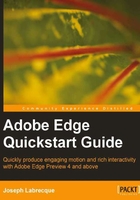
Conventions
In this book, you will find a number of styles of text that distinguish between different kinds of information. Here are some examples of these styles, and an explanation of their meaning.
Code words in text are shown as follows: "These elements will default to a<div> HTML element, but can be changed to employ the following HTML elements instead."
A block of code is set as follows:
(function(symbolName) {
Symbol.bindElementAction(compId, symbolName, "${_fvm001}", "mouseover", function(sym, e) {
// Change an Element's contents.
// (sym.$("name") resolves an Edge element name to a DOM
// element that can be used with jQuery)
sym.$("Info").html("August (2000)");
});
When we wish to draw your attention to a particular part of a code block, the relevant lines or items are set in bold:
Symbol.bindElementAction(compId, symbolName, "${_Rectangle}", "vmousedown", function(sym, e) { sym.playReverse(); // insert code for vmousedown here }); //Edge binding end
New terms and important words are shown in bold. Words that you see on the screen, in menus or dialog boxes for example, appear in the text like this: "Now we will perform the preceding exercise, but this time will employ the Mark to demonstrate an alternate way of creating motion in Edge".